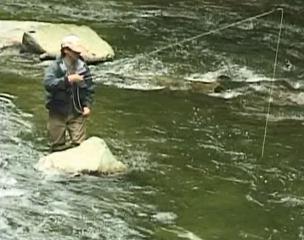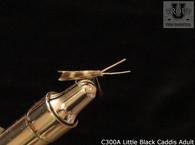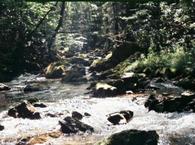
This course discusses the reasons for, and techniques associated with, the high sticking method of fly fishing with nymphs. You will learn the basic tactics to use with high sticking, and what type of water to use it in.
The high sticking method of fishing nymphs is used effectively for fly fishing fast moving runs and riffles, and, under the right circumstances, pocket water. The strong current, typical in streams with a moderate to heavy descent and large sized rocks, creates a unique challenge and opportunity to the fisherman, which high sticking can help address..
The rough water in these turbulent parts of the stream allows you to fish at close range. In fact, you will have to closely and carefully approach your targets (within 15 feet max) to get your fly where it needs to be and to be ready for a strike. Be sure to make slow and deliberate movements to avoid spooking the fish. You may even have to sneak up on the trout, hiding behind boulders as you approach, especially when fishing pocket water.
The main advantage to this type of fishing is having a drift in which the fly is traveling the same speed as, or slower than the current, while keeping your nymph down in the strike zone, often in turbulent water. The basic high sticking technique is based on casting your fly roughly perpendicular (and slightly upstream) into a nearby run (at least 2 – 3 feet deep), while raising your rod throughout the drift to adjust for the slack. You can control the drift nicely with your rod tip, watching vigilantly for the slightest pause or twitch. Be sure to keep the rod tip high, allowing the fly to drift downstream of where you're standing. To be clear, you should keep all slack out of your line and leader at all times, having direct contact with your fly in order to feel the trout take the fly. (Keeping the slack out of the line has the added benefit of keeping most of the line out of the water, limiting unwanted drag.) Then, repeat the cast a little further away. Don't be afraid to set the hook when you sense an unnatural movement. Fish the bottom of the fast current around the large boulders and in the longer runs, by making several successive casts a little further away each time. Continue working upstream in this fashion.
You will want an 8-1/2 to 9-1/2 foot rod, with floating line, and an 8 -9 foot leader. The rougher the water is, the heavier your leader should be, and a 2X – 4X tippet will typically suffice. Fish with 2 – 6 feet of line past the end of the rod's tip, in addition to the leader. Add enough weight about 8 inches above the fly to get the fly to the bottom quickly. You may have to periodically adjust weight if the depth and water speed change significantly as you progress upstream.
For more information on nymphing, see our DVD on Flyfishing Easter Freestone Streams.
Visit our store for a selection of Perfect Fly brand flies.
Gear your rod up as described above, find a stream with some great pocket water, and practice some high sticking.
Review the fly descriptions in our store for information on what nymphs are found in the type of water suitable for high sticking.





